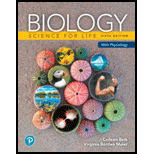
Concept explainers
Support for the endosymbiotic theory for the evolution of eukaryotic groups includes that chloroplasts and mitochondria are surrounded by two membranes, one that derives presumably from the bacterial symbiont and one that derives from the host cell’s vacuole that originally surrounded it. Interestingly, some algal phyla, for instance the Euglenophyta, contain chloroplasts composed of three membranes. Given your understanding of endosymbiosis, how do you think this extra membrane may have evolved?
Want to see the full answer?
Check out a sample textbook solution
Chapter 14 Solutions
Pearson eText Biology: Science for Life with Physiology -- Instant Access (Pearson+)
Additional Science Textbook Solutions
Biological Science (6th Edition)
Genetics: From Genes to Genomes
Campbell Essential Biology (7th Edition)
HUMAN ANATOMY
Biology: Life on Earth with Physiology (11th Edition)
- a) Describe some characteristics and differences between prokaryotic and eukaryotic cells.b) How do the three domains of life differ from one another?c) Two of the organelles in eukaryotes, the mitochondrion and the chloroplast are believed to haveoriginated through a process of symbiosis. Discuss some of the theories of the origins ofmitochondria and chloroplastsarrow_forward1. Why was the great oxygenation event important for mitochondrial development? a) In your own words, define symbiotic. 2. Chloroplasts and mitochondria both contain a circular DNA chromosome, and ribosomes. Why does this evidence support the theory of endosymbiosis as the mechanism for the origin of eukaryotic cells? a) Today, could mitochondria live independently of their eukaryotic cell host? Give two pieces of evidence to support your answer.arrow_forwardDescribe the features of mitochondria and chloroplasts that support the endosymbiotic theory.arrow_forward
- What evidence supports the hypothesis that mitochondria preceded plastids in the evolution of Eukaryotes cells?arrow_forwardThe endosymbiont theory states that mitochondria andchloroplasts evolved from symbiotic relationshipsestablished between bacteria-like cells and theprecursors of eukaryotic cells that engulfed them on what basisarrow_forwardDoes the following phylogenetic tree provide evidence to support or refute the endosymbiosis hypothesis? Briefly explain your choice (1-2 sentences) Bacteria a-Proteobacteria Mitochondria Archaea Eukarya Excavata Discicristata Alveolata Stramenopila Rhizaria Plantae Opisthokonta Amoebozoaarrow_forward
- Under the endosymbiotic theory for the origin of the eukaryotic cell. The ancestor of mitochondria and chloroplasts original became part of mutualism with a larger host cell. Which of the following best explains this mutualism? A) The mitochondria and chloroplasts provided specialized reproduction as part of the proto-germ line while the larger host cell provided energy for growth and reproduction. B) The mitochondria and chloroplasts provided gene products that could be used by the larger host cell for improved parasitization. C) The mitochondria and chloroplasts provided molecular energy in return for protection by the larger host cell. D) The mitochondria and chloroplasts produce toxins that the larger cell utilized to defend itself from other cells mutually increasing the defense of all those involved.arrow_forwardThe prtists that causes malaria evolved from a photosynthetic ancestor and has the remnant of a chloroplast. The organelle no longer functions in photosynthesis, but it remains essential to the protist. Why might targeting this organelle yield an antimalarial drug that produces minimal side effects in humans?arrow_forwardMolecular fossils further indicate the presence of ciliates and dinoflagellates in the emerging eukaryotic world and show that algae were expanding to become major photosynthesizers in the oceans. How can we explain this diversification?arrow_forward
- Imagine you are working in a lab and studying three species of yeast, which are eukaryotic organisms. The first species (Species A) of yeast generates ATP using aerobic cellular respiration. The second species of yeast (Species B) generates ATP using alcohol fermentation. The third species of yeast (Species C) generates ATP using lactic acid fermentation. Which of the following statements are true? All of the other answers are true. Only Species A can grow without oxygen. Species B needs to use 15-16 molecules of glucose to generate the same amount of ATP that is made by Species A using one molecule of glucose. Species C produces more carbon dioxide than does Species B.arrow_forwardWhich of the following pieces of evidence could support the endosymbiotic theory if found to be true? Traces of peptidoglycan in the cytoplasm in eukaryotes Presence of rRNA in eukaryotes Presence of 80S ribosomes in eukaryotes The discovery of a unicellular eukaryotearrow_forwardScientists explain the existence of mitochondria and chloroplasts with the endosymbiotic hypothesis. What is the endosymbiotic hypothesis? Give two pieces of evidence for it.arrow_forward
 Biology Today and Tomorrow without Physiology (Mi...BiologyISBN:9781305117396Author:Cecie Starr, Christine Evers, Lisa StarrPublisher:Cengage Learning
Biology Today and Tomorrow without Physiology (Mi...BiologyISBN:9781305117396Author:Cecie Starr, Christine Evers, Lisa StarrPublisher:Cengage Learning Biology: The Dynamic Science (MindTap Course List)BiologyISBN:9781305389892Author:Peter J. Russell, Paul E. Hertz, Beverly McMillanPublisher:Cengage Learning
Biology: The Dynamic Science (MindTap Course List)BiologyISBN:9781305389892Author:Peter J. Russell, Paul E. Hertz, Beverly McMillanPublisher:Cengage Learning Biology 2eBiologyISBN:9781947172517Author:Matthew Douglas, Jung Choi, Mary Ann ClarkPublisher:OpenStax
Biology 2eBiologyISBN:9781947172517Author:Matthew Douglas, Jung Choi, Mary Ann ClarkPublisher:OpenStax


